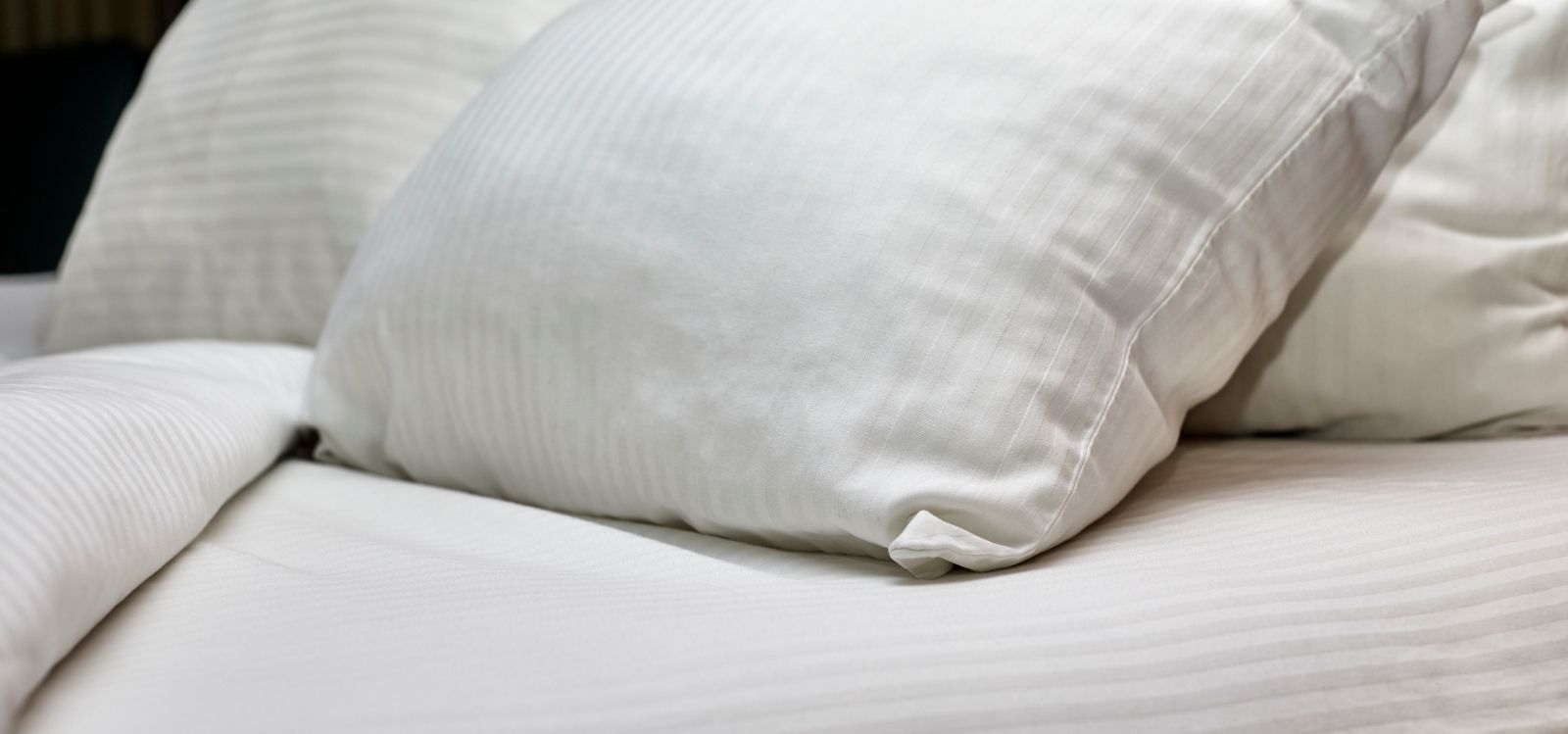Benefits of Feather and Down Pillows - Is there really a difference between feather and down pillows? Which one should you choose to get a good night’s sleep? Although it really boils down to your personal preference, when you understand the differences between the two, you will make a better choice when you shop for the right pillow to get a good night’s sleep.
When it comes to feather and down pillows, many people are confused about the filling materials. As a result, some people prefer feather or down pillows while other may prefer pillows filled with other materials.
Down Pillows
Down is the fuzzy insulator underneath the feathers of a duck or goose. Goose down is larger and fluffier than duck, which is why they seem to be preferred. Larger down clusters provide more loft and will last longer. They are very durable, but some people do have allergies to down. Down pillows are also more expensive, but because they will last the longest with proper care they are a good bargain. You will see a fill number associated with down pillows, like 600, 700, or 800. The higher the fill number, the more loft and firmness you will have with the product.

Feather Pillows
Feather pillows are typically blend of feathers and down. Feathers are heavier and provide more support than down alone. However, they do have quills and will wear down quicker. The quills will poke through and escape the pillow, which is thought to be a sign of good luck. However, as you lose feathers, you lose support. Feather blend pillows are less expensive. Most people grew up with these type of pillows, so it is kind of like sleeping with a comfortable friend.

Enemies of Feather and Down Pillows
Once you find a great pillow, you want it to last. The two biggest cons with feather or down pillows are compression and moisture. Compression cannot be avoided, after all you are placing your head on the pillow every night however look for a pillow that has more than one zone, so that the down or feathers don’t all fluff up at the same side. Down pillows can be re-fluffed in the dryer and by hand, but feather pillows will break down more quickly in the dryer because the quills will break.
Even though ducks and geese both live in the water, moisture will quickly destroy your down or feather pillow. If you live in a humid climate, your pillows absorb this moisture over time. Tossing the pillows in the dryer on high heat to fully dry them will help extend their life. Going to bed with wet hair will impact the life of your feather or down pillows. Your pillow may yellow prematurely when you do not dry your hair before bed.
Perspiration will also affect your pillow. Most people sweat out about one liter of fluid at night. If you have night sweats, your pillow will definitely age faster from the moisture left on it. You may need to dry it more often and leave it on top of the comforter instead of tightly making your bed. Moisturizing creams and oil from your skin will also cause yellowing on your down and feather pillow. However, this can be minimized with pillow covers and cases that protect the pillow
Benefits of Feather and Down Pillows
Both feather and down pillows are light and conserve body heat. They are also cooler when the air is warmer, so they are perfect for all seasons. When you are ready to replace your pillow, check out a down or feather pillow for the perfect support. Know how to care for your pillow, and it will provide many nights of restful sleep.
Here are some facts about feather and down pillows to help you dispel any pillow myths
- Down, Feathers and Allergic Reactions
Down is often attributed to allergic reactions. However, the allergy caused by feathers appears rarely and the allergic reaction may be the result of dust mites and mould, which can thrive inside a pillow. Down and feather pillows often become more allergenic with age as the contamination of the filling continues to increase. Therefore, your down and feather pillows should be replaced with new ones roughly even 6 months.
- Down Pillows Are Not Animal-Friendly
Down feathers are not harvested in a cruelty free manner. In fact the feathers may be plucked from live birds. In addition, some birds may be slaughtered for meat and then boiled in order to loosen the feathers. These feathers are then removed by hand or by using a machine. If ending animal cruelty is important for you, opting for pillows that are made from other filling materials is probably the best option. Supporting these practices by buying down and feather pillows only causes the industry to continue producing these pillows. Instead, you may choose to opt for pillows that have synthetic or plant-based filling materials.
Down Pillows Are Not Animal-Friendly
Down feathers are not harvested in a cruelty free manner. In fact the feathers may be plucked from live birds. In addition, some birds may be slaughtered for meat and then boiled in order to loosen the feathers. These feathers are then removed by hand or by using a machine. If ending animal cruelty is important for you, opting for pillows that are made from other filling materials is probably the best option. Supporting these practices by buying down and feather pillows only causes the industry to continue producing these pillows. Instead, you may choose to opt for pillows that have synthetic or plant-based filling materials.
- Down and Feather Pillows Trap Heat
It is true that you may feel uncomfortably warm in bed while using down and feather pillows. These pillows can trap heat, leaving you feeling uncomfortable at nighttime. In addition, since the pillows can not easily air dry, sweating into your down and feather pillows each night could make it harder to sleep. In the summertime using down and feature pillows may cause you to feel uncomfortable while you sleep. In cooler weather, down and feather pillows draw in heat for more restful sleep.
- Cleaning These Pillows Is Difficult
When you clean your feather and down pillows, you may shorten the lifespan of your pillows by cleaning them improperly. If you want to help your pillows to last longer avoid using the hot setting on the dryer as it can scorch the filling. You also want to avoid leaving a wet pillow to sit in a damp area, which can attract mould.
- Down and Feather Pillows Must Be Maintained
Down and feather pillows can lose their shape over time and become lumpy if they are not properly cared for. Avoiding moisture and not drying the pillow on high heat can help the pillow to retain its shape. You may also have to periodically fluff the pillows to ensure that they can still hold their shape. You may need to take some time to find the right pillows for your needs. However, if you aren’t a fan of the extra maintenance required for down and feather pillows, you may need to find other options for filling materials.
One of the best down pillows on the market is the Sleepezy 2 Zone Pillow. It’s an adjustable pillow with two chambers separated by a sealed inner wall which means the down feathers won’t move all to one side. The zip access allows you to add, delete or move filling around to raise or lower the pillow to suit you. The Sleepezy 2 Zone Pillow is designed to support the neck and cradle the head.
At Therapeutic Pillow, we know how important it is to get a good night’s rest, which is why we offer speciality pillows that cater to your specific needs.
Do you want to learn more? Read our Frequently Asked Questions for...
In modern society, some people are a lot more sensitive to a whole host of different products and airborne nasties.
With regards to polyurethane foam, history can only prove it is certainly not a risk.
In Australia alone thousands of tonnes of foam are produced and sold into areas such as bedding, furniture, automotive, yes products we are exposed to daily.
Hospitals for instance will not accept Latex foam as it is rubber-based, and all hospital mattresses are made from polyurethane foam.
 0
0 0
0No, down pillows are not necessarily bad for asthma. While some people with asthma may be sensitive to certain allergens, such as dust mites, which can be found in down feathers, it does not mean that all individuals with asthma will have a negative reaction to down pillows.
It is important to note that down pillows can be hypoallergenic, meaning they are designed to minimize the risk of triggering allergies or asthma symptoms. These pillows are often made with special materials or treated to reduce allergens. However, it is always recommended to check the product description or label to ensure that the down pillow you choose is hypoallergenic if you have asthma or allergies. Additionally, regularly washing and maintaining your pillow can help minimize allergens and keep it clean for a healthier sleep environment.
 0
0 0
0Duck feather pillows are not inherently cruel, but the ethical concerns lie in the sourcing and production processes. Feathers used in pillows can come from ducks that are raised for meat or from live-plucked ducks. Live-plucking involves removing feathers from ducks while they are still alive, which is considered inhumane and cruel. However, many reputable manufacturers now follow strict guidelines and source feathers from ducks that are raised for meat, ensuring that the feathers are a byproduct of the food industry and not obtained through live-plucking. To ensure you are purchasing ethically sourced feather pillows, look for certifications such as the Responsible Down Standard (RDS), which guarantees that the feathers used in the pillows are responsibly sourced and obtained without causing harm to the ducks.
It is important to be aware of the sourcing and production methods when considering feather pillows. By choosing pillows that are certified by organizations like RDS, you can support ethical practices and ensure that the feathers used are obtained without causing harm to ducks. This way, you can enjoy the comfort and support of feather pillows while also promoting animal welfare.
 2
2 0
0Yes, latex pillows can be beneficial for neck pain. Latex is a natural material derived from rubber trees, known for its supportive and contouring properties. These pillows are designed to provide proper alignment and support to the neck and head, which can help alleviate neck pain. Latex pillows offer a unique combination of softness and firmness, allowing them to conform to the shape of your neck while still providing adequate support. The natural elasticity of latex also helps to maintain the pillow's shape and prevent it from flattening over time. Additionally, latex pillows are hypoallergenic and resistant to dust mites, making them a suitable choice for individuals with allergies or asthma. Overall, latex pillows can offer a comfortable and supportive solution for those seeking relief from neck pain.
 0
0 0
0Latex pillows are indeed a good choice for many people. Made from natural latex derived from rubber trees, these pillows offer several benefits. Firstly, latex pillows provide excellent support and comfort for your head and neck. The natural elasticity of latex allows the pillow to conform to the shape of your head, providing optimal alignment and reducing pressure points. This can help alleviate neck and shoulder pain, promoting more restful sleep. Additionally, latex pillows are hypoallergenic and resistant to dust mites, mould, and mildew. This makes them a great option for those with allergies or asthma, as they can help minimize potential triggers. Overall, latex pillows offer a durable and supportive sleep surface, ensuring a comfortable and healthy night's rest.
 0
0 0
0








